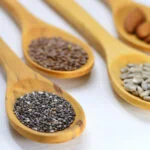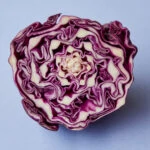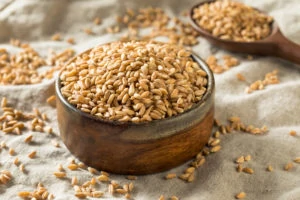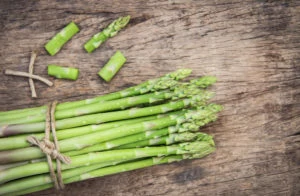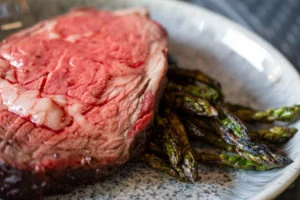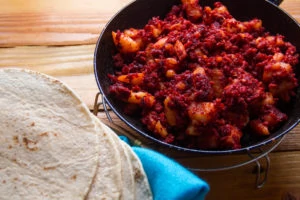This two-day rosemary focaccia bread has a recipe rating of 5 out of 5 in my circle.
Make focaccia bread in the evening or early morning. Snack on it throughout the day or serve it with a meal.
Rosemary Focaccia Bread Recipe
This rosemary focaccia recipe uses freshly brewed rosemary tea to bloom the yeast, plus a topping of fresh, chopped rosemary.
Some really salty, fresh if you can, large-flake salt used to make a salt brine, and large doses of extra virgin olive oil also make this bread really crunchy — the best part of focaccia. Alternative toppings in place of rosemary are unending, but some go-to’s have got to be cherry tomatoes and Spanish olives.
This rosemary focaccia bread is perfect for sopping up the juices on your plate, all by itself. Leftover focaccia is so yummy, split down the middle, with sandwich fixings like bitter greens and a fried egg inside.
Rosemary Focaccia Recipe (Step-by-Step)
Focaccia dough ingredients:
- 2 1/2 cups (600 grams) room-temperature rosemary tea
- 1 1/2 teaspoons baker’s yeast
- 3 teaspoons (12.6 grams) honey
- 5 1/2 cups (800 grams) all purpose flour
- 3 tablespoons (42.52 grams) big-flakey Jacobsen or Maldon sea salt, plus another pinch for finishing
- 1/2 cup (100 grams) olive oil
- 2 teaspoons fresh or dried rosemary
Additional optional ingredients:
- 2 minced garlic cloves
- Sliced cherry tomatoes
- 2 teaspoons fresh herbs, chopped
Brine ingredients:
- 1 1/2 teaspoons (5 grams) sea salt
- 1/3 cup (80 grams) room-temp water
You’ll also need a large bowl, stand mixer (optional), whisk or fork, metal spatula, a rimmed baking pan, and a pizza stone or cast iron skillet (another baking pan also works).
Step 1: Make Rosemary Tea
Combine the water, honey, and 4 teaspoons of chopped, fresh or dried rosemary. Bring to a full boil (212°F) for 5-10 minutes, then cool to room temperature (110°F).
Step 2: Make the Dough, First Proof
Combine room-temperature rosemary tea with the active dry yeast, or bakers yeast, and honey (about the same amount of granulated sugar can be used to make this recipe naturally vegan). Whisk until the honey is dissolved. Let the mixture proof while you combine 5 1/3 cups of the all purpose flour (this bead recipe doesn’t use whole wheat flour) and salt in a big bowl. Save the remaining flour for dusting your hands during the shaping stage.
Add fresh garlic to this step if you like, minced, and a couple of teaspoons of fresh rosemary or other fresh herbs for a garlic herb bread flour mix.
Once the yeast mixture looks frothy, add it to the flour mixture and add the olive oil. Stir by hand or in a stand mixer with a dough hook until the shaggy dough is completely combined.
Cover the bowl of dough with cling-on (not a damp towel) and let the dough rest in a warm place overnight to rise and ferment. A sunny spot away from cold drafts is ideal, so the dough can double in size.
Step 2: Shape the Dough
When the dough has doubled in size, prepare a rimmed, baking sheet by slathering it in good drizzle of olive oil.
Fold the dough on itself once, then pour or pull the dough with your hands out of the bowl and onto the prepared pan. Dust your hands first with flour if the dough seems to stick. Rub another glug of olive oil over the top of the dough.
Stretch out the dough to the size and shape of the baking sheet by sliding your hands beneath the dough and gently spreading your hands apart to stretch.
Let the dough rise for half an hour and check a couple of times throughout the rise to re-stretch the dough as it shrinks away from the baking sheet’s edges.
Step 3: Dimple and Brine the Dough, Final Proof
Use your fingers to dimple the dough.
How do you Dimple Dough?
This is the fun part. Use your three middle fingers, angled at about 45 degrees, and press into the dough until you feel resistance. Fill the dough with rows of dimples, each about an inch apart. More dimples mean more pools of brine and olive oil and a crispier and tastier focaccia bread crust.
Prep the Brine
Combining warm water with salt. Whisk to dissolve the salt. Pour the brine over the face of the dough, filling the dimples.
Set the focaccia dough aside with a warm, damp towel covering it, to proof for 45 minutes.
Step 4: Preheat Oven
While the dough proofs, with about 15 minutes to spare, put a pizza stone or an inverted baking sheet in the oven on a middle oven rack. Preheat the oven to 450°F.
Step 5: Add the Toppings, Bake
When the dough has risen and is light and bubbly, add flaky sea salt and any toppings to the focaccia dough.
Put the bread in the oven on the baking stone, inverted baking sheet or cast iron pan, and bake for 25 minutes.
At 25 minutes, check the bottom crust by lifting the focaccia bread with a metal spatula. If the crust is a golden brown color, bake for just 5 minutes extra to brown the top crust. If the bottom isn’t quite yet lightly browned, add 5 minutes more for the bottom crust, then around 5 minutes after that for the top crust.
Step 6: Remove Focaccia From the Oven, Brush With Oil
Immediately after removing the focaccia bread from the oven, brush a healthy coat of olive oil on the top, letting the oil pool in the dimples.
Let the baked focaccia bread cool for a few minutes in the pan, then use a metal spatula to release the bread from the pan and slide the bread onto a rack to cool.
Step 7: Serve or Store Focaccia
You can serve focaccia warm, or let the bread cool completely before serving. Both warm and cooled focaccia tastes delicious.
Store the focaccia bread and maintain its chewy texture by wrapping it in parchment paper and keeping it in an sealed container. Or, wrap in plastic wrap and freeze.
Frozen focaccia can be thawed in an oven. Toughened, leftover focaccia bread tastes delicious, and a little more olive oil just before serving it is yummy. Focaccia is also an easy homemade bread to warm in the oven or toaster.
How to Shape Focaccia Bread
Shape focaccia dough by stretching it with your hands instead of rolling it out with a rolling pin to maintain the dough’s surface tension and result in a smooth crust.
Slide your hands under the focaccia bread dough, palms up, and gently move your hands apart and up and down like a scale to stretch the dough to the size of the baking sheet. Repeat if the dough shrinks in from the edges of the baking pan.
To keep the dough from sticking to your hands, dust your hands lightly in flour if the dough isn’t very oily, or if it’s an especially oily dough, rub a tablespoon of oil into your hands before stretching the dough.
Focaccia With a Crispy Cheese Crust
Crunch is a repeating theme of this focaccia bread crust, bottom and top, created with salty brine, olive oil before and after baking, flaky salt, and maybe some cheese.
In his book Grains for Every Season, Joshua McFadden recommends a pizza dough idea for a super nice and crispy bottom crust, and the idea could be a golden adaption for focaccia bread.
Shred a layer of cheese onto the pan before laying in your focaccia bread dough for a really crispy, umami cheese bottom.
Focaccia Salt Brine
Saltiness is what gives focaccia crust its intense, so-crusty, clean, and tasty finish. Once your focaccia dough is dimpled, make a brine from a moist, super salty salt to give the bread the yummiest crust.
Look for salt like sea salt for a really salty taste, and fresh or locally harvested, if you’re lucky, for rich moistness that gobs up when you pinch it. My sister recently visited Nicaragua, where she found moist sea salt that made her think of this focaccia bread recipe.
Focaccia With Extra Virgin Olive Oil
Don’t be scant in your olive oil on focaccia’s crust. Add a long drizzle just before baking and before sprinkling salt on the dough, and then again as soon as the bread comes out of the oven, drizzle — nearly pour — your extra virgin olive oil so it pools in the crust’s dimples. Leave it to seep into the golden-brown crust, and don’t be afraid to add a little more just before serving.
Focaccia With Chopped Rosemary
Chop several spoonfuls of fresh rosemary and sprinkle on the focaccia dough, after the brine and olive oil, and before sprinkling flaky salt.
Other Toppings for Focaccia Bread
Focaccia toppings are limitless, and some favorites, after fresh rosemary, include thinly sliced tomatoes or halved cherry tomatoes, Italian seasoning, balsamic vinegar, maple syrup, more olive oil, garlic herb oil, Parmesan cheese, fresh garlic, roasted garlic, minced garlic, fresh herbs, caramelized onions, and olives. Poke tomatoes in deep.
Great olives can be found in the deli section of most grocers, and the best are sold in European markets, in glass cases next to the cheese. Try 6 to 7 different green or Spanish olive varieties.
Be creative and try different toppings. Combine toppings like tomatoes and rosemary, or poke a topping into half of your dough and add a different topping to the other half.
Sprinkle With Flaky Sea Salt
Giant salt crystals add a pretty addictive crunch to a focaccia’s crust, and that’s the best part of this fresh rosemary focaccia bread. Look for finishing salt or flaky sea salt like Maldon’s really crunchy pyramid crystals. Sprinkle generously just before popping the bread into the oven so the flakes don’t have time to dissolve in the briny, oily dough. Be sure to add flaky sea salt after adding fresh herbs (like the fresh rosemary in this bread recipe) to keep the salt dry.
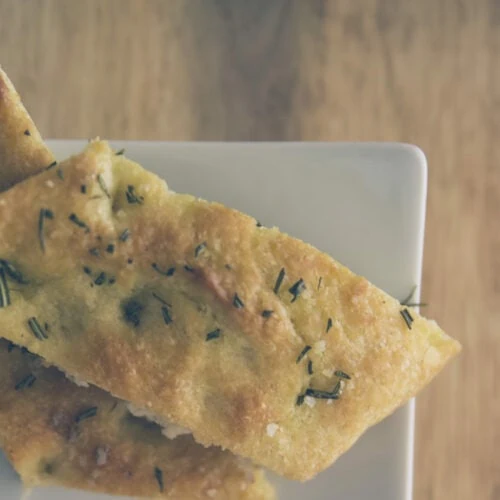
Garlic and Rosemary Focaccia Bread
Emily SeguraEquipment
- 1 Medium-sized bowl
- 1 Big bowl
- 1 Whisk
- 1 Cling-on
- 1 Baking sheet with a rim 18-by-13 inches
- 1 Pizza stone or another baking sheet
- 1 Metal spatula
- 1 Parchment paper
- 1 Sealable bag or container
Ingredients
Dough
- 2 1/2 cups lukewarm rosemary tea
- 1 1/2 teaspoon baker's yeast
- 3 teaspoons honey
- 5 1/3 cups all purpose flour
- 2 tablespoons Large-flake sea salt
- 1/2 cup olive oil plus more for pan and finishing
- 2 cloves garlic
- 2 teaspoons rosemary
Brine
- 1 1/2 teaspoons Sea salt
- 1/3 cup Room-temp water
Instructions
- Combine room-temperature rosemary tea with the active dry yeast, or bakers yeast, and honey. Whisk until the honey is dissolved. Let the mixture proof while you combine 5 1/3 cups of the all purpose flour and salt in a big bowl.Once the yeast mixture looks frothy, add it to the flour mixture and add the olive oil. Stir until shaggy and combined.Cover the bowl of dough with cling-on (not a damp towel) and let the dough rest in a warm place overnight to rise and ferment.
- When the dough has doubled in size, prepare a rimmed, baking sheet by slathering it in good drizzle of olive oil.Fold the dough on itself once, then pour or pull the dough with your hands out of the bowl and onto the prepared pan.Rub olive oil over the face of the dough.Stretch out the dough to the size and shape of the baking sheet by sliding your hands beneath the dough and gently spreading your hands apart to stretch.Let the dough rise for half an hour and check a couple of times throughout the rise to re-stretch the dough as it shrinks away from the baking sheet's edges.
- After half an hour of rising, make dimples in the bread dough with your fingers. Prepare salt brine by combining salt and room-temp water. Stir to dissolve the salt. Pour the brine over the face of the dimpled dough, letting it pool up in the dimples. Proof the dough for 45 minutes.
- After half an hour of proofing, preheat the oven to 450°F and put a pizza stone or upside-down baking sheet on the rack in the center of the oven.
- After the 45-minute proof, sprinkle flaky sea salt over the focaccia dough, and add any other toppings like fresh herbs, garlic, or sliced tomatoes or olives. Put the focaccia in the oven on top of the pizza stone or inverted pan, and bake for 25 to 30 minutes. Check with a metal spatula that the bottom is golden-brown and crusty. If it's not, add 5 minutes. Once the bottom is crusty, add another 5 minutes to brown the top crust.
- Take the focaccia out of the oven and glug a little olive oil over the top, letting it pool in the dimples and soak in. Let the bread cool in the pan for 5 minutes. Remove from the pan with a metal spatula to cool the rest of the way on a baking rack, or serve.
- Serve the bread while it's still warm, after cooling in the pan for 5 minutes, or after it has cooled completely.
- Focaccia can be stored well for 5 days wrapped in parchment paper and in a sealed container or bag. Toast leftover focaccia to reheat. Focaccia can also be wrapped in parchment paper and frozen, in an air-tight container or bag, and thawed in the oven on broil to reheat.


